

Collaborative Individualized Education Plans. Evidence-Based Practice Summaries. Title Description Evidence Base/Source Accelerated Reader™: Adolescent Literacy Accelerated Reader™ is a computerized supplementary reading program that provides guided reading instruction to students in grades K–12.
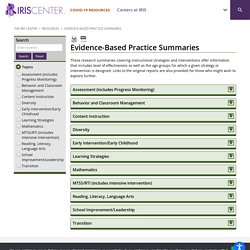
It aims to improve students' reading skills through reading practice and by providing frequent feedback on students' progress to teachers. This program was found to have no discernible effects on reading fluency or comprehension for adolescent learners. Accelerated Reader™: Beginning Reading Accelerated Reader was found to have mixed effects on comprehension and no discernible effects on reading fluency for beginning readers. Accelerated Reader™: English Language Learners This program has not yet been proven effective on ELL.
Alphabetic Phonics Alphabetic Phonics is a multisensory curriculum that can be used individually or in small groups. Test-taking strategies for kids with learning difficulties. Effective study strategies are the gateway to school success, graduation, college entry, and job advancement.
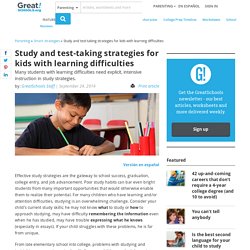
Poor study habits can bar even bright students from many important opportunities that would otherwise enable them to realize their potential. For many children who have learning and/or attention difficulties, studying is an overwhelming challenge. Consider your child’s current study skills; he may not know what to study or how to approach studying, may have difficulty remembering the information even when he has studied, may have trouble expressing what he knows (especially in essays).
If your child struggles with these problems, he is far from unique. Disability Resources & Educational Services - University of Illinois. Strategies to enhance peer feedback. Some strategies are particularly suited to younger students, where often the names that teachers have for these strategies provide a 'shorthand' way of communicating to students that they wish them to provide peer feedback.
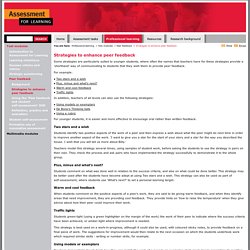
For example: In addition, teachers of all levels can also use the following strategies: For younger students, it is easier and more effective to encourage oral rather than written feedback. Evaluation / LD Testing. Common Signs of Learning Disabilities. LD Basics Click here to download the "Taking the First Step" parent guide.* The good news about learning disabilities is that scientists are learning more every day.
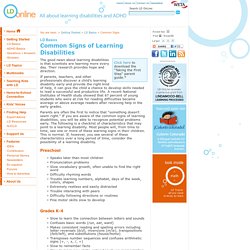
Their research provides hope and direction. TransitionPlanningResourceGuide4. Transitions. What are they?

A group of orientation programs, strategies and interventions that help students as they move from elementary to secondary school. Who are they for? Students adjusting to high school. How do they help? Young Children Sept 2009 Partnerin D7536CF6133CB. Paving the Way to Kindergarten for Young Children with Disabilities. The night before my son was to start kindergarten, we snuggled in bed to read Tom Goes to Kindergarten, by Margaret Wild and David Legge, a lighthearted and humorous look at the separation anxiety felt by both children and parents.
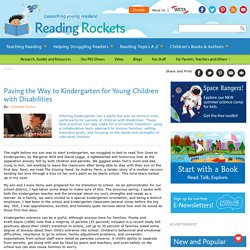
We giggled when Tom's mom and dad clung to him, not wanting to leave the classroom after being able to stay with their son on the first day. Next, we read The Kissing Hand, by Audrey Penn, a tender story of a mother raccoon sending her love through a kiss on her son's palm as he starts school. This time tears welled up in my eyes. 4.4 Transitions - CONT 816 001 Teaching Students with Communication Needs (Learning Disability) W20. 4 Reasons to Teach Your Kids About Sustainability - Ecopedia. Sustainability isn’t just for adults: Kids should be encouraged to learn about environmental issues and to think about the consequences of their purchases, choices and behaviors, just as we adults do!
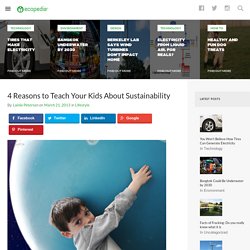
While learning to be green can be a challenge, it’s one that we should definitely share with our children. When we start doing things differently around the house, such as recycling, composting or using non-toxic household cleaners, we owe it to our kids to explain why we are doing this. When we explain the significance of our choices, children can begin to understand the impact human beings can have on the future of our planet.
They can also learn about other values, such as responsibility, thrift, and care for others, including non-human animals as well as future generations of human beings. Here are four reasons why you should teach your kids about sustainability: 1. 2. 3. Consumers who have educated themselves have an easier time choosing sustainable products and services. 4. 1. 2. 3. Elementary School Educational Lesson Plan - National Bullying Prevention Center. Use the Kids Against Bullying website as a resource tool in your classroom.
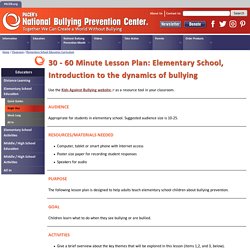
Appropriate for students in elementary school. Suggested audience size is 10-25. Computer, tablet or smart phone with Internet access Poster size paper for recording student responses Speakers for audio The following lesson plan is designed to help adults teach elementary school children about bullying prevention. Children learn what to do when they see bullying or are bullied. Teaching Students to Prevent Bullying. By Phil Nast, retired middle school teacher and freelance writer Student bullying is one of the most frequently reported discipline problems at school: 21% of elementary schools, 43% of middle schools, and 22% of high schools reported problems with bullying in 2005-06.
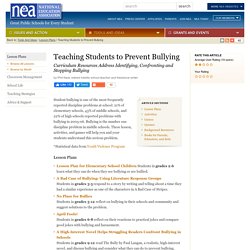
Bullying is the number one discipline problem in middle schools. These lesson, activities, and games will help you and your students understand this serious problem. Lesson Plans Lesson Plan for Elementary School Children A Bad Case of Bullying: Using Literature Response Groups Students in grades 3-5 respond to a story by writing and telling about a time they had a similar experience as one of the characters in A Bad Case of Stripes. How to Adapt Your Teaching Strategies to Student Needs. Resources - LD@school. 245 results out of 245 posts What strategies can we use to improve a student’s flexibility?

Published February 18, 2020, by LDAOeng Much of the time, flexibility problems persist less because of a lack of objectively good strategies and more because of a lack of the motivation, engagement, and interest to get behind a strategy and apply it. 0 Comments FREE WEBINAR: Understanding Non-Verbal Learning Disabilities – From Diagnosis to Intervention Published February 13, 2020, by LDAOeng Non-verbal learning disability (NVLD) is a frequently misunderstood and misused diagnosis.
Individual Education Plan (IEP) • Collaborate with in-school team of teachers and administrators and other education professionals who are involved with the student. • Establish set meeting times for IEP collaboration with staff – often at the beginning of the year and prior to reporting periods for revisions. • Collaborate with student and parents/guardians – Set a meeting. • Use assessment data (teacher-based and professional, if available). • Develop specific accommodations (with the exception of some students who are solely identified with giftedness and who are on extended programs). • If needed, develop modifications with an annual goal and specific expectations for each subject area that differs from the curriculum for the student’s grade level. ADCET Home - ADCET. Seven Habits of Highly Effective IEP Teams. Be proactive "Taking initiative does not mean being pushy, obnoxious, or aggressive. It does mean recognizing our responsibility to make things happen.
" Fundamental in our efforts to become proactive members of IEP teams is adopting an attitude that is collaborative, facilitative, and responsible. To be proactive requires a shift in our thinking from a deficit based model of education to a capacity model. Often, goals for IEPs are developed as a result of a label, or something that appears to be 'wrong'--i.e. reacting to a behavior that others do not think is acceptable. Individual Education Plans (IEP) and Transitions. Individual Education Plans (IEPs) are a critical tool in driving achievement and well-being for students with special education needs. Please find below samples to support educators when developing IEPs. The samples have been developed with and informed by consultations with educators and stakeholders. There are some components of the IEP samples which will be new for school boards and are based upon the consultation that took place to inform the samples.
For example: In addition to professional assessments, the use of other relevant assessment data including teacher assessments, teacher observations, teacher/student conferences are demonstrated; Learning expectations are expressed in such a way that is measurable and observable and the student and parent(s) can understand exactly what the student is expected to know or to be able to do; and Transition plans reflect the requirements of Policy/Program Memorandum (PPM) 156. Teach Special Education. Page for specific accommodations related to student needs. • Be specific with the accommodations that will best meet the student’s learning needs. • Limit the accommodations to the most important in each category of instructional, environmental and assessment. • Utilize non-teacher professional reports and recommendations.
The Difference Between Accommodations and Modifications. Planning and Teaching with Explicit Instruction - LD@school. Assistive Technology for Reading. For people who struggle to read text, technology can be a lifeline. An audiobook, for example, allows them to experience a story they might not be able to access with a traditional book. These (AT) tools for reading are inexpensive and easy to find. But with so many tools out there, it’s not always easy to know which ones to use. To help, here’s a guide to AT tools for reading and where to find them. Assistive Technology for Kids with Learning Disabilities: An Overview. Assistive Technology. Webinar Recording: Math and LDs - Using Assistive Technology and Project-Based Learning to Support All Students - LD@school. Add to favorites Click here to access the transcript of this webinar.
Click here to access Richard Parker's slides. About the webinar: Math has become a hot topic in Ontario and yet, despite our best efforts, students with LDs can still be left behind. IEP Development for a Student with a Learning Disability: The Power of Accommodations - LD@school. Add to favorites The team has made the decision; an IEP will be developed to further support the student. The process begins and sometimes those collaborating in the development of the IEP can end up feeling quite overwhelmed. Learning Theories and Models summaries - Educational Psychology. Vygotsky. Lev Vygotsky's Sociocultural Theory By Saul McLeod, updated 2020 The work of Lev Vygotsky (1934) has become the foundation of much research and theory in cognitive development over the past several decades, particularly of what has become known as sociocultural theory.
Vygotsky's sociocultural theory views human development as a socially mediated process in which children acquire their cultural values, beliefs, and problem-solving strategies through collaborative dialogues with more knowledgeable members of society. Vygotsky's theory is comprised of concepts such as culture-specific tools, private speech, and the Zone of Proximal Development.
Vygotsky's theories stress the fundamental role of social interaction in the development of cognition (Vygotsky, 1978), as he believed strongly that community plays a central role in the process of "making meaning. " Young Teens (12-14 years old) Your Child's Strengths: Discover Them, Develop Them, Use Them by Jenifer Fox. The Dyslexia-SpLD Trust - Home.
Improving Reading Skills for Students with Learning Disability & ADHD - LDRFA. Dan Siegel - "Flipping Your Lid:" A Scientific Explanation. The 2x10 strategy: a miraculous solution for behavior issues? Understanding Children's Hearts and Minds: Emotional Functioning and Learning Disabilities. Misunderstood Minds . Writing Difficulties. What are strategies for teaching a student with a math-related learning disability? Math Learning Disabilities. Principles and Standards. Misunderstood Minds . Basics of Math. Using Collaborative Strategic Reading. Secret Code Actions - Research and Links. The International Dyslexia Association Ontario Branch. Phonological and Phonemic Awareness. Early Reading Strategy. NICHD - Eunice Kennedy Shriver National Institute of Child Health and Human Development. Supporting Student Success in Literacy. Landmark School Resources. Teaching Time Management to Students with Learning Disabilities.
Voices. Canadian Dyslexia Association Canadienne de la Dyslexie. ED521836. Adolescent Literacy 101. Misunderstood Minds . Attention. Visual and Auditory Processing Disorders. Wilma Jean the Worry Machine. Teach Special Education. National Council for Special Education - CPD and In-School Support. 20141125113826. Tip Sheet NLDs. Confronting the Puzzle of Nonverbal Learning Disabilities. Video: Nonverbal Learning Disabilities Basics. Teaching Strategies For Students With A Nonverbal Learning Disorder. DYSLEXIA. Non-Verbal Learning Disability. LD Report 1 Intro to LD. What Are LDs? – Learning Disabilities Association of Ontario – LDAO.